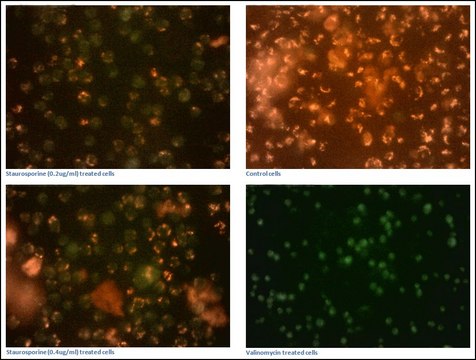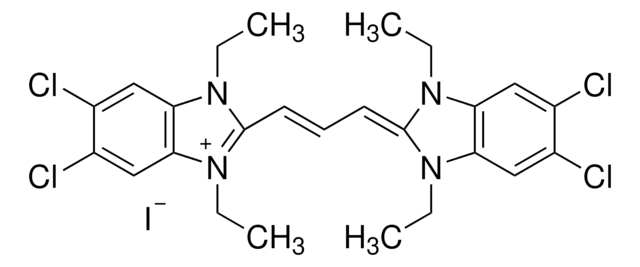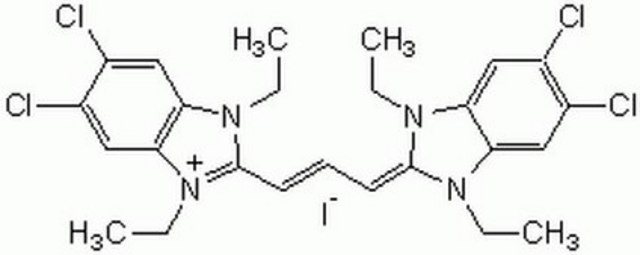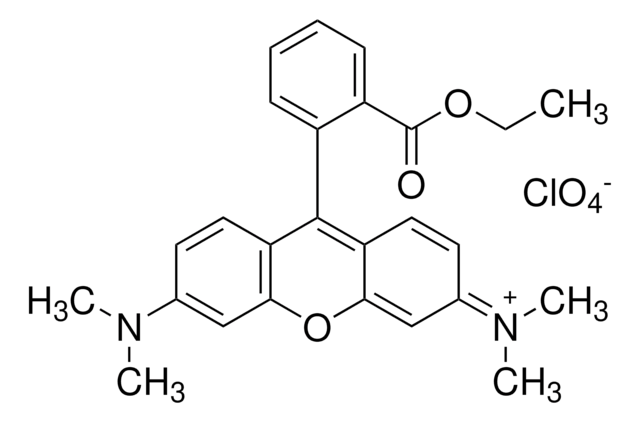MAK160
Mitochondrial Membrane Potential Kit
sufficient for 100 fluorometric tests (flow cytometry)
Synonym(s):
JC-10 Assay
Sign Into View Organizational & Contract Pricing
Select a Size
All Photos(2)
Select a Size
Change View
About This Item
UNSPSC Code:
12161503
NACRES:
NA.25
Recommended Products
usage
sufficient for 100 fluorometric tests (flow cytometry)
detection method
fluorometric
relevant disease(s)
cancer
storage temp.
−20°C
Related Categories
General description
Mitochondria generate a potential across their membranes due to the activities of enzymes of the electron transport chain. During apoptosis, collapse of the mitochondrial membrane potential (MMP) coincides with the opening of the mitochondrial permeability transition pores, leading to the release of cytochrome c into the cytosol, which in turn triggers other downstream events in the apoptotic cascade.
Application
Mitochondrial Membrane Potential Kit has been used to detect mitochondrial membrane potential (MMP) of PC-12 cells.
Suitability
This kit is suitable for the flow cytometric detection of Mitochondrial Membrane Potential in mammalian cells and for screening apoptosis inhibitors and activators.
Principle
This kit utilizes JC-10, a superior alternative to JC-1, for determining the loss of the MMP in cells. Although JC-1 is widely used in many labs, its poor water solubility often results in precipitation in aqueous buffers when used at higher concentrations. At higher concentrations, JC-10 exhibits greater aqueous solubility than JC-1. Similar to JC-1, JC-10 is a cationic, lipophilic dye that is concentrated and forms reversible red-fluorescent JC-10 aggregates (λex = 540/λem = 590 nm) in the mitochondria of cells with a polarized mitochondrial membrane. In apoptotic cells, MMP collapse results in the failure to retain JC-10 in the mitochondria and a return of the dye to its monomeric, green fluorescent form (λex = 490/λem = 525 nm). This kit can be used for monitoring apoptosis and for screening apoptosis inhibitors and activators.
Storage Class Code
10 - Combustible liquids
WGK
WGK 1
Flash Point(F)
Not applicable
Flash Point(C)
Not applicable
Choose from one of the most recent versions:
Already Own This Product?
Find documentation for the products that you have recently purchased in the Document Library.
Intramembrane protease PARL defines a negative regulator of PINK1-and PARK2/Parkin-dependent mitophagy.
Meissner C, et al.
Autophagy, 11(9), 1484-1498 (2015)
Jianbiao Zhou et al.
Haematologica, 105(9), 2286-2297 (2020-10-16)
Differentiation therapies achieve remarkable success in acute promyelocytic leukemia, a subtype of acute myeloid leukemia. However, excluding acute promyelocytic leukemia, clinical benefits of differentiation therapies are negligible in acute myeloid leukemia except for mutant isocitrate dehydrogenase 1/2. Dihydroorotate dehydrogenase catalyses
Radix Ophiopogonis polysaccharide extracts alleviate MPP+-induced PC-12 cell injury through inhibition of Notch signaling pathway.
Liu R and Li X
International Journal of Clinical and Experimental Pathology, 11(1), 99-109 (2018)
Chaolu Chen et al.
Free radical biology & medicine, 136, 22-34 (2019-03-31)
Endometriosis is associated with inflammatory reaction, and reactive oxidative species (ROS) are highly pro-inflammatory factors. Mitochondria are responsible for the production of ROS and energy. However, little is known about how mitochondria regulate ROS generation and energy metabolism in endometriosis.
Daniela Marina Malcervelli et al.
Cryobiology, 95, 97-102 (2020-05-31)
Boar spermatozoa are extremely sensitive to low temperatures and the cryopreservation causes dramatic changes in sperm survivability, but it is not clear which part of the cryopreservation process affects the most. The aim of this work was to assess early
Articles
Cellular apoptosis assays to detect programmed cell death using Annexin V, Caspase and TUNEL DNA fragmentation assays.
Our team of scientists has experience in all areas of research including Life Science, Material Science, Chemical Synthesis, Chromatography, Analytical and many others.
Contact Technical Service




